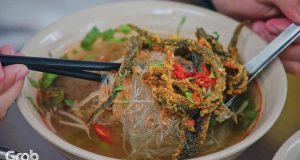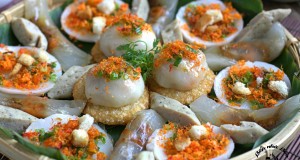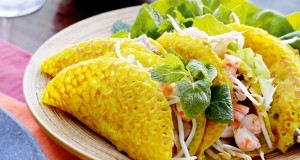On Vietnamese Food Culture, the daily meal for most of the Vietnamese family includes:
- Individual bowls of rice
- Boiled, grilled, steamed and fried meat or fish or some seafood dish
- Stir-fried steamed or raw vegetable dish
- Vietnamese-style soup
- Prepared soy sauce and fish sauce for dipping purpose.
All dishes apart from the individual bowls of rice are communal and to be shared.
Northern Vietnamese cuisine is not bold in any particular flavor – sweet, salty, spicy, bitter, or sour. Most Northern Vietnamese foods feature light and balanced flavors that result from subtle combinations of many different flavoring ingredients. The use of meats such as pork, beef, and chicken were relatively limited in the past. Freshwater fish, crustaceans, and mollusks – such as prawns, shrimps, crabs, oysters, and mussels… – are widely used. Many notable dishes of Northern Vietnam are crab-centered (e.g., bún riêu). Fish sauce, soy sauce, prawn sauce, and lime are among the main flavoring ingredients. Being the cradle of Vietnamese civilization, Northern Vietnam produces many signature dishes of Vietnam, such as phở, bún riêu, bún thang, bún chả, bánh cuốn… which were carried to Central and Southern Vietnam through the road of Vietnamese migration.
The abundance of spices produced by Central Vietnam’s mountainous terrain makes this region’s cuisine notable for its spicy food, which sets it apart from the two other regions of Vietnam where foods are mostly non-spicy. Once the capital of the last dynasty of Vietnam, Hue’s culinary traditional features are highly decorative and colorful food, reflecting the influence of ancient Vietnamese royal cuisine. The region’s cuisine is also notable for its sophisticated meals constituted by many complex dishes served at small portions. Chili peppers and shrimp sauces are among the frequently used ingredients. Some Vietnamese signature dishes produced at this region are bún bò Huế, bánh xèo, bánh bèo…
The warm weather and fertile soil of Southern Vietnam create an ideal condition for growing a wide variety of fruit, vegetables, and livestock. As a result, foods in Southern Vietnam are often vibrant and flavorful with liberal uses of garlic, shallots, and fresh herbs. Sugar is added to food more than in the other regions. The preference for sweetness in Southern Vietnam can also be seen through the widespread use of coconut milk in Southern Vietnamese cuisine. Vast shorelines make seafood a natural staple for people in this region. Southern Vietnam has also been the region where influences from foreign cuisines (Chinese, Indian, French, and Thai etc.) are most prominent.
The Vietnamese ethnic minorities’ cuisine: Cuisine of each ethnic minority has its separate identities. Known as pig meat mixed Phèo non of ethnic minorities in the Central Highlands, Bánh cuốn trứng (Cao Bang, Lang Son), Bánh coong phù of the Tay minority, suckling pigs and ducks roasted with móc mật (a special spice leaf kind), Khâu Nhục in Lang Son, etc.
Cuisine represents the spirit culture of the Vietnamese. Daily meals are considered family reunion meal, people happily gather together after a hard working day.

Rice – the main ingredient in most of Vietnamese meal

Fish sauce – one of special spices of Vietnamese people. In addition to being added to dishes during the cooking process, fish sauce is also used as a base for a dipping condiment.

Phở (Vietnamese noodle) and Bun Cha (bún chả) are two most famous foods among many local specialities
of the northern Vietnam.

Bánh Xèo (sizzling cake) is named for the loud sizzling sound it makes
when the rice batter is poured into the hot skillet.

Hủ Tiếu – a popular local dish in the south of Vietnam
Read more about Vietnamese Food Culture here!
 Vietnam Travel Guide Backpacking and Individual Travel Blog
Vietnam Travel Guide Backpacking and Individual Travel Blog






